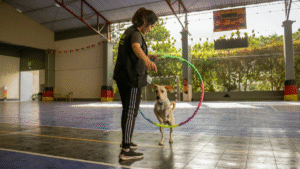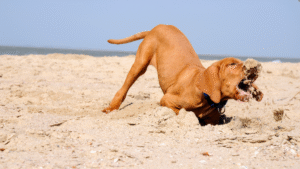Dog training can feel like a battle—but that might mean you’re trying too hard. A well-behaved, happy, and confident dog isn’t the result of occasional marathon training sessions.
Training becomes easier when you establish simple daily habits that reinforce good behavior, strengthen your bond, and make your dog a more eager learner.
Daily dog training habits work for both puppies and adult dogs. Whether you have a rescued dog or a young puppy at home, the right daily routines can make a significant difference in your training success.
Let’s get started:
1. Keep Training Sessions Short
Dog training doesn’t need to be one long, drawn-out session each day. While consistency is important, few things make training harder than marathon sessions where your dog loses interest.
Dogs—especially puppies—have short attention spans. Your best approach is to schedule a few short, frequent sessions each day rather than one long one.
Five to ten minutes, two or three times a day, is usually all it takes to make real progress. This approach keeps your dog engaged and focused, which leads to faster learning and less frustration for you.
For example, you could start with a short session before breakfast, practice leash training during an afternoon walk, and finish the day with a few minutes of recall practice before dinner.
By incorporating a few minutes of training into your daily routine, your dog learns through repetition and consistency. Dogs thrive on predictability, so the more consistent your sessions are, the easier training will become.
2. Train Your Dog During Everyday Activities
You don’t need to carve out special blocks of time each day for training to be effective. Incorporating training into everyday activities makes life easier for both you and your dog.
For example, you can ask your dog to “sit” before putting on their leash or to “wait” before eating. Practice “stay” when you open the door or “come” when you call them from another room. By turning daily moments into training opportunities, your dog learns that good behavior is expected all the time—not just during formal sessions.
This habit also helps reinforce your role as a calm, consistent leader. When your dog understands that you’re in charge, they’re more likely to look to you for guidance and stability.
Real-life examples:
-
Have your dog “sit” before greeting guests.
-
Use “leave it” when they get overly interested in something outside.
-
Teach impulse control by having them “stay” while you set down their food bowl.
The more you integrate training into everyday life, the more naturally your dog will follow commands, making future training easier and more effective.
3. Reward Good Behavior and Ignore the Bad (Sometimes)
Positive reinforcement is the foundation of effective dog training. Dogs repeat behaviors that earn rewards, so the more you praise and reinforce good actions, the faster your dog will learn.
Keep a few small treats or pieces of kibble handy throughout the day. When your dog behaves well—sitting calmly for the leash, coming when called, or greeting guests politely—reward them immediately. Timing is critical; dogs associate rewards with behavior within just a few seconds.
On the other hand, avoid overreacting to minor misbehavior. Yelling or scolding can confuse your dog and make training more stressful. Instead, calmly redirect their energy toward a better behavior. For example, if your dog jumps on guests, turn away and only give attention when all four paws are on the ground.
Tip: Dogs are sensitive to tone. Use a cheerful, encouraging voice when praising them. Simple phrases like “Good sit!” or “Nice stay!” go a long way.

4. Stick to a Daily Routine
Dogs are creatures of habit. A predictable daily routine helps them feel calm and secure—which in turn makes training much easier. When your dog knows when to expect meals, walks, playtime, and rest, they’re less likely to develop anxiety or unwanted behaviors.
Try to maintain consistency in:
-
Meal times
-
Potty breaks
-
Walks and exercise
-
Playtime
-
Training sessions
Structure helps prevent common behavior problems like barking, chewing, or separation anxiety because your dog knows what to expect.
Even if your schedule isn’t always exact, try to keep the general rhythm of your day consistent. This teaches patience, self-control, and focus—qualities that make every training session more effective.
5. Exercise Both Body and Mind Every Day
Physical and mental exercise are essential for well-behaved dogs. Without enough stimulation, dogs often turn to destructive habits such as chewing, digging, or excessive barking.
Make sure your dog gets enough physical exercise for their breed and age. This could include daily walks, fetch, agility training, or playtime at the park. But don’t overlook mental stimulation—it’s just as important.
Ideas for mental enrichment include:
-
Puzzle toys or treat-dispensing toys
-
Hide-and-seek games
-
Scent or “find it” games
-
Short training challenges or new tricks
Activities that engage your dog’s mind help them stay calm, obedient, and alert. Training becomes much easier when your dog isn’t overflowing with pent-up energy or boredom.

6. Socialize Your Dog Regularly
Socialization isn’t just for puppies—it’s a lifelong habit that helps dogs stay confident, calm, and well-adjusted. A well-socialized dog is far easier to train than one that’s fearful or reactive.
Gradually and positively expose your dog to new sights, sounds, people, and other dogs. You can do this by:
-
Taking short car rides to new places or parks
-
Walking on different surfaces (grass, gravel, sand)
-
Introducing friendly dogs one-on-one in neutral territory
-
Allowing your dog to observe children, cyclists, or traffic from a safe distance
Pair every new experience with praise, treats, and calm reassurance. Never force interaction—let your dog explore at their own pace.
When dogs learn that new environments are safe and rewarding, they become more relaxed, adaptable, and responsive in any situation.
7. Stay Patient and End Every Day Positively
Patience is one of the most important habits in dog training. It takes time, repetition, and understanding for dogs to fully grasp what you’re asking of them. Some days it may seem like your dog has forgotten everything—and that’s perfectly normal.
Instead of getting frustrated, end each day on a positive note. Spend a few minutes playing, cuddling, or simply relaxing together. This reinforces your bond and reminds your dog that training is part of a loving relationship, not a punishment.
Your bond is the “secret ingredient” that makes all other training habits work better. Dogs who trust their owners are more willing to learn and eager to please.
Remember, your dog doesn’t need perfection—they need consistency, clarity, and kindness.

Conclusion
Making training easier isn’t about quick fixes or strict methods—it’s about developing habits that build trust, structure, and mutual respect. These seven daily habits work together to create a lifestyle of consistency, positive reinforcement, and emotional balance.
Let’s recap:
-
Keep sessions short and consistent.
-
Integrate training into daily life.
-
Reward good behavior and redirect bad.
-
Maintain a daily routine.
-
Exercise your dog’s body and mind.
-
Socialize regularly and positively.
-
Be patient and end each day with positivity.
When you treat training as a natural part of your daily life rather than a separate task, it becomes more fun, relaxed, and effective. Over time, your dog will become more attentive, obedient, and calm in every situation.
Every interaction with your dog is an opportunity to teach something—so make each moment count. With consistency, empathy, and these daily habits, you’ll find that training your dog is less about control and more about teamwork. That’s how you build a truly happy, well-behaved companion.
Final Thoughts
Dog training success doesn’t happen overnight—it’s a gradual process built on small, steady actions. Think of these daily habits as investments in your dog’s future behavior and your shared happiness.
Stay consistent, stay positive, and make training part of your everyday life. When you do, obedience, trust, and good manners will come naturally—and you’ll build a deeper bond with your dog along the way.
- 5 Cheap Alternatives To Dog Training Equipment - November 12, 2025
- Homemade Calming Spray To Help Dogs During Training - November 12, 2025
- 7 DIY Dog Training Tools You Can Make From Household Items - November 12, 2025

